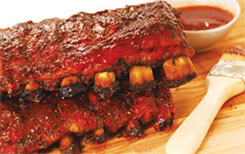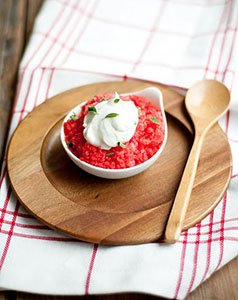What's sweet and versatile but doesn't come in a bag or box? The newest addition to C&H® Sugar's product line: C&H Organic Agave Nectar! It's the delicious liquid sweetener you squeeze into your favorite recipes for beverages, baked goods, and savory dishes.
We're celebrating agave's arrival with new recipes that take full advantage of agave nectar's unique properties—like delectably moist Carrot Cake Agave Muffins and sweet and tangy Agave Lime Marinade—and with insights from bakers who share with us their enthusiasm for agave. We're convinced you'll be as excited about agave as we are!
All About Agave
Although C&H Organic Agave Nectar is new to our product line, agave sweeteners are hardly a recent discovery: They've been enjoyed for thousands of years by the indigenous people of Mexico and what's now the southwestern and western United States. The nectar—called aguamiel, or "honey water," in Spanish—comes from a succulent plant, Agave azul (blue agave). (When it's distilled, the sap is used to produce tequila. However, agave nectar contains no alcohol.)
Our agave nectar comes from Agave azul plants that are organically grown for seven to ten years before being harvested. The leaves are cut off and sap is extracted from the core, which resembles a pineapple and is called a piña. A heating process purifies the nectar. Depending on the degree of heat, we're able to produce two types of nectar: Light Agave Nectar, which adds pure sweetness to delicate desserts such as Agave Cheesecake; and Amber Agave Nectar, whose darker color and subtle caramel flavor is perfectly suited to rich desserts such as our dark, dense Agave Chocolate Cake or to savory sauces such as Tangy Agave BBQ Sauce.
Agave nectar has the consistency of honey and tastes a bit like honey, although people who don't like honey often enjoy agave nectar. Unlike honey, agave nectar doesn't crystallize; it keeps in your pantry—no refrigeration required—for two years after it's packed. (To learn how to decipher the date code on each bottle, read our Frequently Asked Questions.) It has about 25 percent more calories than sugar (sucrose), but because agave is sweeter than sugar you'll find you use less of it.
Agave nectar has another benefit for people with sugar sensitivity, including some people with diabetes or pre-diabetes: It has a low glycemic index (GI), which means it raises blood sugar more slowly than other sweeteners. If you're concerned about blood sugar and insulin, talk to your doctor about introducing agave nectar into your diet.
An Agave Expert
Mani Niall doesn't simply appreciate agave nectar's "mellower" properties: he was inspired to create recipes that take advantage of it. A professional baker for more than 25 years—he is currently the executive chef for the San Francisco Bay Area's Just Desserts and the proprietor of Mani's Test Kitchen—he's an expert in liquid sweeteners: He started his career in a restaurant where all the baked goods were made with honey and later opened a bakery that used fruit-juice concentrates instead of sugar. "Then I discovered agave," he says. "It has a ‘cleaner' taste profile than other liquid sweeteners. I really like it with fruit desserts—it accentuates the taste of the fruit without overpowering it."
Mani shows what he means in his cookbook Sweet! From Agave to Turbinado, Home Baking with Every Kind of Natural Sugar and Sweetener (Da Capo Press, 2008). Because "the honeylike flavor of agave goes beautifully with citrus flavors" and adds desirable moisture to cakes, he uses it in a delectable recipe for Lemon Cupcakes with Mascarpone Cream and Raspberries. (If you can't find rich Italian mascarpone cheese, substitute cream cheese.)
Mani also likes to use agave syrup in savory dishes such as his simple yet flavorful Chile-Rubbed Agave Chicken. "Hot and sweet and harmonize together very nicely," he notes. "In this case, ancho chile already has a sweet note of its own that is accented by the agave syrup."
An Agave Experimenter
Bay Area food blogger Stephanie Shih, the author of Desserts for Breakfast, first discovered agave nectar "about seven or eight years ago," when she was living in Berkeley, California. (She's still in the Bay Area, where she's pursuing a graduate degree in linguistics.) She began experimenting with agave nectar in beverages and liked what she tasted. "Agave nectar dissolves more easily than sugar does, especially in iced tea or iced coffee," she says. "And unlike honey, it doesn't have a distinct taste—which is perfect if you don't want honey-flavored tea, for instance." (We also like our new liquid sweetener in Agave Sangria—a delicious summertime party drink.)
Stephanie wanted to explore agave's possibilities in dessert-making, so from cold liquids she moved on to frozen liquids—specifically granita, the granular Italian ice that's usually flavored with sugar syrup. "Unlike ice cream, granita is quite forgiving, so I thought it would be the perfect, fail-safe place to start," says Stephanie. "I calculated the right proportion by flavoring the liquid to taste before freezing, based on how much sugar I would put in if that's what I were using instead." Her Watermelon and Strawberry Granita with Thyme-Infused Cream builds on fruit-flavored granita sweetened with agave nectar, and then adds the aromatic surprise of thyme leaves. Serve it for dessert or as a refreshing snack or salad course.
If you're new to granita, Stephanie offers a helpful tip: "Have patience, because the granita needs to be stirred in the freezer every 30 minutes or so. Just scrape up the ice crystals that form around the edges of the pan until you reach a lighter-than-air and ultra-fluffy ice."
More Agave Ideas
Here are some additional suggestions for using agave nectar:
- Substitute agave nectar in any recipe calling for simple syrup, such as Strawberry Melon Granita or our Velvet Rope cocktail. (Chef Mani Niall notes that you may need to shake a beverage a little longer when you make it with agave nectar instead of simple syrup.)
- Pour agave nectar instead of maple syrup over pancakes, waffles, or hot oatmeal.
- Drizzle agave nectar over plain yogurt and top with fresh fruit for a fast, delicious dessert.
- Ellen Jackson, the subject of our Baker's Profile, suggests substituting agave nectar for any other liquid sweetener (corn syrup, honey, maple syrup) in recipes. No other adjustments are necessary.
- Another tip from Ellen: When substituting agave nectar for a dry sweetener in a baked recipe, reduce the oven temperature by 25°F.







No comments:
Post a Comment